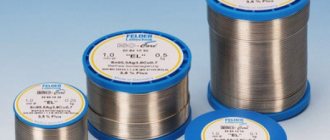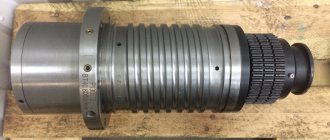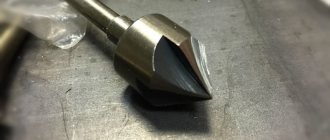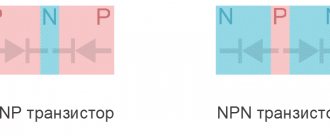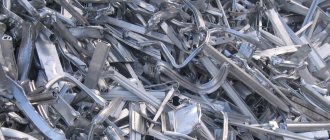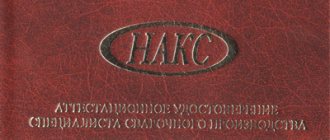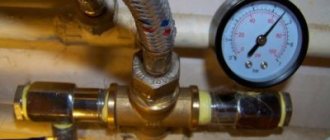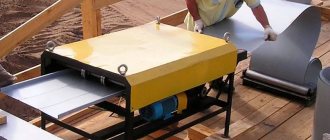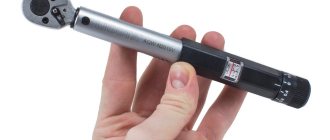Learning to hold a soldering iron in your hands, as well as how to use it correctly, is a lot, but not enough for the repair of electrical equipment or microcircuits to be truly high-quality. It is necessary to study additional materials that are necessarily used in the soldering process, for example, solder fat, the correct use of which significantly improves the result of the entire work. This will be discussed further.
What is solder fat
Don't let the word "fat" confuse anyone. Flux has nothing to do with organic matter. In fact, the pancreas is a chemical combination of various reagents. In its appearance and some properties the substance resembles lard. In practice, two types of flux are used: neutral and active flux.
Advantages
Specialists and radio amateurs choose soldering oil because of a number of its advantages:
- flux ensures uniform coverage of the soldering area with solder;
- Tinning metal surfaces helps achieve a mirror effect;
- the high viscosity of the substance allows you to maintain an accurate dosage within the intended limits;
- after soldering is completed, excess gel is easily washed off with water or a special solvent;
- market availability and low price are some of the attractive features of PG.
Flaws
- The pancreas has an unpleasant odor, which is especially active during soldering;
- Active flux is aggressive towards thin contacts of electronic parts;
- Fumes from molten flux are harmful to breathing. When working, you need to use personal protective equipment (gauze bandage, glasses).
How to use it correctly
After purchasing the solder fat composition, all that remains is to find out the rules for its use. In order for such a soldering flux to fulfill its task, you need to follow these steps:
- Ensure good ventilation of the room and respiratory protection.
- Prepare the surface by cleaning it and degreasing it.
- Make tinning. Before this, the soldering iron tip is first placed in flux, and only then a little special solder is taken. The molten tin will help the solder distribute better.
- The surface on which soldering will be done is also covered with fat. The layer should be thin, but sufficient to cover all irregularities and gaps.
- The soldering surface is heated by the soldering iron tip, which causes the fat composition to heat up. When melted, it will eliminate oxides, stretching across the surface. When the flux burns out completely, a film will remain that will protect the metal from corrosion and oxidation. Now you can apply solder.
- The parts that need to be soldered are connected to each other. Solder is applied to them in a thick layer. It covers the entire seam with a small margin.
All that remains is to clean the soldering area from traces of fatty flux. For this, isopropanol or gasoline is used.
Before starting work, you should also check whether the solder fat has deteriorated. To do this, a little flux is placed on the metal and then heated. The moisture will evaporate, leaving a white coating, which should also begin to melt and stretch in an even layer. But sometimes this does not happen, the plaque begins to form into balls. This means that you can no longer use the fat composition.
Composition of solder fat, physical and chemical properties
Neutral flux is an alloy of rosin and stearin. Active solder fat is a complex composition. This is paraffin, petroleum jelly, zinc chloride and ammonium mixed with dielectric water.
Soldering gun
The gel applied to the contacts of radio components becomes like a form that the molten solder takes. The properties of the PG provide an ideal flat surface of the applied metal. The solder spreads in an even layer without bumps or depressions.
The viscous structure of the flux allows you to initially outline the contours of future soldering. When the soldering iron tip is heated, the flux liquefies, which helps the solder softly and quickly take the desired shape.
Important! The properties of solder gel make it possible to create connections between metal parts of complex configurations.
Soldering basics and technical chemistry for the soldering process 13
In the previous article, we looked at one of the traditional types of fluxes used for soldering microcircuits - rosin, as well as its advantages and disadvantages. Today we will look at another type of flux - solder fat.
In the Radio-sale.ru catalog, many visitors interested in technical chemistry have probably already noticed the presence of such a product as “soldering fat”.
But if almost everyone who has encountered soldering at least once in their life knows about rosin as a flux, not everyone has thought about such an option as soldering fat, and not even everyone knows about it.
Let's say right away that solder fat as a type of flux occupies a special place and therefore, in part, amateurs, especially beginners, have little or almost no knowledge of this substance.
But real professionals know well about soldering fat and actively use it, since thanks to it the quality of soldering is significantly improved.
Solder fat has, as you may have guessed, a special chemical composition and consistency, which makes it look very similar to fatty deposits of animal origin. This is what led to such an unusual name.
Composition and properties of solder fat
Although outwardly, as already mentioned, solder fat is indeed similar to ordinary animal fat, however, this similarity is deceptive.
Let's look at what solder fat consists of, but first, let's note that today two types of this substance are used in practice: active and neutral solder fat.
Each of them has its own characteristics of chemical composition and, as a consequence, characteristics of application.
Neutral solder fat
Thus, neutral solder fat is created from a mixture of rosin and stearin (as we see, rosin with all its advantages and disadvantages could not be avoided here). It is this chemical composition that explains why, due to neutral solder fat, it is possible to dissolve the oxide film that forms on the surfaces of the parts being joined.
In addition, the neutral type of fat helps make the soldering process easy and smooth. The solder becomes more fluid, distributed evenly and penetrates into any irregularities and crevices.
Also, a clear advantage of neutral solder grease is its good solubility, thanks to which the user can easily wash off the residue using ordinary water or any organic solvent.
Active solder fat
Now about active solder fat. Its composition contains petroleum jelly, ammonium and zinc chlorides, deionized water and paraffin. In general, an explosive mixture, which, by the way, can be dangerous to your health, which is why when working with active solder fat you should always take care of good ventilation of the workplace.
The characteristics of the composition also determine the scope of application of active solder fat, however, we will talk about the features of using both types of solder fat in the next article.
Overview of species
Soldering flux - what is it and what is it for?
There are two types of fat flux:
- Passive (neutral).
- Active.
Passive
Stearic-rosin flux is called neutral fat. It is used for soldering printed circuit boards of mobile phones and other complex electronic devices. Flux removes the oxide film of the metal, removes various foreign and oxide films during soldering of copper using lead-tin solder.
The product has found wide application not only in industry, but also in everyday life. The flux adheres well to any metal contacts. Due to its viscosity, accurate dosing of the material and high speed of solder application are achieved.
The gel is applied with a wooden stick, toothpick or match. At the end of soldering, the remaining flux is washed off with Galosh gasoline, isopropanol or a special remover.
Soldering fat neutral
Active
Active flux is used for soldering heavily corroded parts made of different metals. The product is used to restore corroded contacts of radio components of devices that have been damaged by moisture.
A board that has been in water for some time is tried to remove rust as much as possible with alcohol. Active soldering flux is applied to contacts damaged by rust. They are then soldered with solder. The remaining gel is washed off with warm water.
Active flux
Features of choice
To decide on the type of flux, you should know what it is for. If you plan to work with parts in normal condition, then it is enough to use a neutral product.
In cases where it is necessary to prepare the soldering of old radio components under difficult conditions, active fat is used.
Note! Upon completion of soldering work, the installation site must be thoroughly cleaned of active flux. The slightest residue can provoke the resumption of corrosion processes on the board.
Features of choice
The choice of a specific composition is determined by the list of works, materials and sizes of parts to be soldered.
For soldering ordinary, not overly oxidized parts, you can safely choose a neutral soldering flux. It is less harmful and its residues are easier to remove. In addition, there is no risk of secondary corrosion processes caused by fat residues.
If parts and structures that are heavily corroded and contaminated are used, then active fat takes advantage.
It makes sense to evaluate the packaging of the formulations. If you do not have practical experience in using this flux, or the amount of work to be done is limited, then it is better to purchase small jars.
Soldering with neutral fat
After you are convinced of the high quality of the fat and its compliance with the intended list and scope of work, you can take large packages - per unit of weight they will cost significantly less.
Making solder fat with your own hands
Pulse soldering iron gun
On the Internet you can find a lot of recipes for making homemade solder fat. The product contains various chemical ingredients.
All recipes have one goal in common - to achieve maximum adhesion of the lead-tin alloy and displacement of oxides from the soldering process. Fat compounds are divided into passive and active compounds.
Making neutral fat
Neutral flux is a rosin-stearic mixture. Both reagents are commercially available. The manufacturing process consists of the following stages:
- Rosin is ground to a fine powder and placed in a glass jar.
- Stearin is also poured there. The mixture is made up in a 1:1 ratio.
- The jar with the contents is heated in the microwave.
- The oven is set to medium power mode and turned on for 4 minutes.
- The mixture turns into a homogeneous viscous mass.
Rosin for soldering
The resulting neutral solder grease may have insufficient viscosity. Some experts advise adding palm kernel oil (cooking fat). In this case, the proportion of the composition of the pancreas will be as follows:
- rosin - 3 hours;
- stearin – 2 hours;
- cooking oil – 1 tsp.
The addition of palm kernel oil gives the product a density that makes the gel convenient for loading it into a syringe.
Production of active solder fat
To make active flux you will need the following components:
- paraffin;
- zinc chloride;
- deionized water;
- petrolatum;
- ammonium chloride.
Paraffin
The substance is a by-product of oil refining. It is a white plastic fusible material. You can buy paraffin at household chemical stores.
Zinc chloride
The chemical is a white crystalline powder. Its melting point is 3200 C. Easily dissolves in water, alcohol, glycerin and acetone. The average price of zinc chloride is 220 rubles/kg.
Deionized water
Water is purified in a special installation from ions of impurities of various substances. It is most often purchased in pharmacies or online stores. The average price of 1 liter is 80 rubles.
Petrolatum
The purified petroleum product is sold in pharmacies and cosmetics stores. It is inexpensive - from 40 rubles. for the tuba.
Ammonium chloride
Ammonium chloride, or ammonia, is an odorless, white crystalline powder. Finding it on sale is not difficult. Half a kilo of the product can be bought for 150 rubles.
There are no exact instructions for preparing active solder fat. Usually all components are mixed in approximate proportions:
- Vaseline – 10%;
- zinc chloride – 10%;
- ammonia – 10%;
- paraffin – 28%;
- deionized water – 2%.
The resulting product is stored in a closed container (a glass jar with a lid), which is kept in a dark and cool place.
Homemade solder fat
Cooking recipes
Sometimes, when repairing electrical appliances at home, there is an urgent need to create a soldering mixture with your own hands. The manufacturing process itself does not require much effort or money, the main thing is to have the necessary material available and follow the sequence of actions.
To obtain neutral solder fat, it is necessary to place rosin in a container and bring it to the melting stage. Then, stirring, add stearin. As the mass cools, its viscosity can be determined. If the fat hardens quickly, the procedure is repeated, adding stearin until the desired consistency is obtained.
Preparing an active mixture at home is a difficult process, requiring the exact percentage of all components. For fat you need:
- water – 2%;
- technical petroleum jelly – 10%;
- zinc chloride – 10%;
- GOI pastes 54 – 78%.
Pour zinc chloride powder into a porcelain bowl, add water and slowly stir gently. Technical Vaseline is added to the resulting mass. Everything is mixed until a homogeneous liquid is formed.
GOI paste is added into the resulting emulsion in small portions. The finished mixture is thoroughly stirred to evenly distribute all components and placed in a jar.
How to use soldering oil
The viscous consistency of the product makes it easier to apply flux to the desired soldering points. The flux is transferred with a toothpick or any convenient oblong object. Solder fat is loaded into the box of a disposable syringe. With its help, it is good to control the dosage of the gel.
Before applying flux, the soldering area is cleaned of various contaminants. To do this, use gauze swabs, clean rags or any cloth soaked in a detergent solution. As a last resort, wipe the contacts with alcohol.
Copper tinning with neutral fat
Important! Under no circumstances should traces of gel be left after soldering. Remaining fat is removed with special solvents and soap solution. Active fat is especially dangerous. Its particles can cause corrosion of connections of radio components.
Benefits of soldering fat
- Neutral soldering fat has high solderability properties, which significantly improve this process;
- When treated with grease, tinning of the contacts and the surface of the material is facilitated;
- The material is easily washed off when particles or a small layer remains after work;
- This is a common and affordable flux with a relatively low cost;
- The material leaves virtually no marks, and the solder spreads very well, leaving no sharp corners;
- Fat does not spoil the base material and does not corrode it.
Flaws
- Cannot cope with difficult places that are heavily covered with oxides;
- Working with such a flux can be harmful to health, since it contains various chemicals that are released during evaporation during contact with high temperatures;
- After work, a lot of fat remains on the base material, which requires additional cleaning;
- The working process is not as comfortable as when using other fluxes.
Composition and physicochemical properties
Neutral solder fat contains a rosin-stearic base. The composition of the material is noticeably simpler than in the active one. The properties of the material ensure an easy and soft process. Here there is a smooth distribution of solder over the entire surface. Thanks to this, it becomes more fluid and can penetrate into all cracks and irregularities, which ensures better joining. Also, after processing there are no tubercles, sharp edges that appear after the soldering iron comes off, and so on.
Soldering fat on the metal surface
Another property of the material is its good solubility, since it is easily washed off from the surface with water, not to mention other solvents of organic origin. At room temperature, the flux is viscous and malleable. It can be easily distributed to all important places and even used for thin areas of microcircuits. When the temperature rises, it first becomes liquid and then burns out, leaving behind a protective film that prevents the formation of oxides and other negative elements.
Features of choice
Having figured out how to use solder fat, it is worth considering the features of its choice
First of all, you need to pay attention to the standards by which it is made. You should pay attention to which GOST is on the box, and most importantly, whether it exists at all
After all, some manufacturers may produce their products according to their own standards, which does not guarantee their quality. This does not mean at all that this material will not be intended for soldering or that any foreign components will be found in its composition. It’s just that the quality of connections with such varieties will not be as high as with those created according to certain GOSTs.
Next, you need to pay attention to the total mass that is in the package. Neutral solder fat 20 g
packaging is a standard option that is perfect for the private sector. For professionals, a larger volume is required, since if a person is used to soldering with such a flux, then not everyone will want to switch back to rosin or soldering acid. Here it makes sense to take a larger container that can last much longer. At the proper level of storage, the material does not deteriorate.
Popular brands and manufacturers
On the modern market you can now find several types of manufacturers that supply neutral solder fat. Among them are the following:
- Technocom;
- EAT;
- Smoltekhnokhim.
Features of application and soldering
Like any other soldering agent, soldering flux has its own application characteristics. When using this type of flux, the following factors should be considered:
- Heated fat releases dangerous toxic fumes that have a dangerous effect on the respiratory and visual organs. Soldering must be done in a room with forced ventilation;
- To avoid the occurrence of corrosion processes in radio components after soldering, the board is thoroughly cleaned of flux residues;
- Do not use the active fat composition for soldering microprocessors and electronic parts with thin contacts;
- The best means for applying solder gel is a plastic syringe without a needle.
For those who have only used soldering oil once, flux becomes a must-have tool for soldering the most complex connections of printed circuit boards and simple radio circuits. Soldering fat can be purchased ready-made or made by yourself. It all depends on the capabilities and preferences of the home craftsman.
Advantages and disadvantages
Both types of flux have both their advantages and disadvantages. The neutral composition has the following advantages:
Neutral fat has a number of disadvantages. These include the following properties:
- it is difficult to solder parts covered with rust;
- after soldering is completed, a solid residue remains on the surface;
- soldering with it is less comfortable than with other fluxes (flux paste, LTI-120).
The active composition also has many advantages. Its advantages:
- It is better than other fluxes for soldering the surfaces of parts made of ferrous and non-ferrous metals.
- Even highly oxidized materials can be soldered with it;
- flux residue is easily removed after soldering is completed;
- the composition has a low cost and a long shelf life.
When working with active fat, precautions must be taken. It has the following features:
- when heated with a soldering iron, the composition releases harmful substances, so the workplace must be equipped with ventilation;
- to prevent corrosion, after soldering is completed, flux residues are removed from the surface;
- The active substances in the flux can damage thin wires or electronic components, so it is not suitable for delicate soldering.
This is interesting: Semi-automatic welding - in shielding gas, in carbon dioxide
